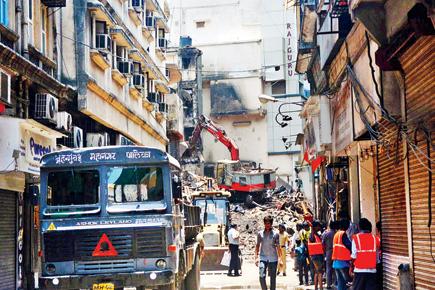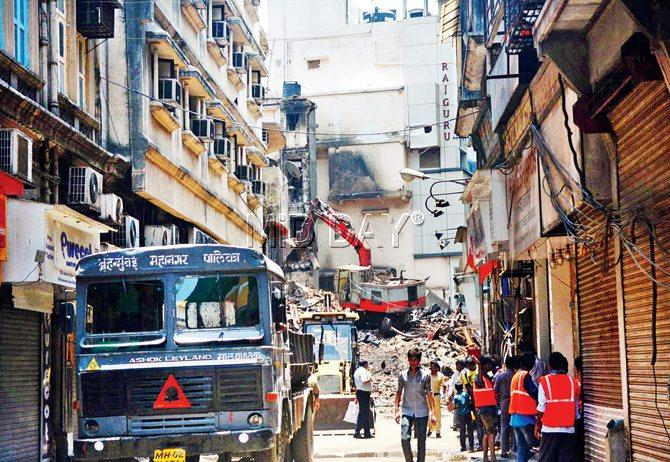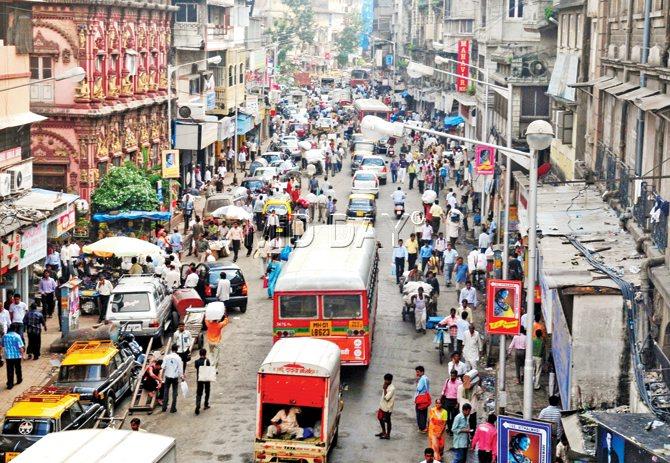Experts say Saturday’s fire in Kalbadevi should serve as a wake-up call for the government; add that these areas in South Mumbai need special status for their much-needed redevelopment

Fire trap: Narrow lanes in the area hampered the entry of fire engines on Saturday
With people packed like sardines in rundown, age-old residences, the areas of Kalbadevi, Chira Bazaar, Opera House, Bhuleshwar and others that make up the BMC’s C Ward are home to slums masquerading as buildings.
ADVERTISEMENT
Watch video: Fire engulfs building in South Mumbai; 2 firemen dead

Fire trap: Narrow lanes in the area hampered the entry of fire engines on Saturday. Pic/Bipin Kokate
Experts say Saturday’s fire in Kalbadevi, which claimed the lives of two firemen and led to several others being injured, should serve as a wake-up call to planners, who have allowed the status quo to persist, condemning the areas to languish in slum-like conditions with no respite in sight, and leaving the door open to more such tragedies.

With its narrow roads, densely packed buildings and large population, Kalbadevi is a redeveloper’s nightmare. FILE PIC
Architects and experts say the only solution is planned redevelopment in clusters, but the small plot areas, narrow roads, high number of tenants, stringent government norms, housing regulations, height restrictions and, sometimes, even the reluctance of tenants and owners, has ensured that the plan never got off the ground. Even government agencies claim they couldn’t get the redevelopment of Kalbadevi, which is one of Mumbai’s oldest markets, started because of various reasons, with government regulations topping the chart.
Also Read: Cash, valuables lie scattered on open ground
The icing on the cake is that even the buildings that get redeveloped end up having nearly the same conditions as their predecessors, perpetuating the areas’ image as that of slums in all but name.
Man-made disaster
Rajesh Vardhan, MD of Vardhaman Developers, which takes up redevelopment of buildings in these areas, said, “There are nearly 4,000 buildings in C-ward. The buildings are very old, and are mixed use. This was a man-made disaster, but imagine what will happen if there’s an earthquake. The old settlements, which are four to five storeys tall, will crumble.”
Hurdles abound
Arqam Shaikh, owner of ARC associates, an architecture firm which is engaged in the redevelopment in the south of the city said the road width is one of the biggest hurdles for the redevelopment of the areas.
“Even if a builder wants to redevelop, we cannot actually do it, because of the clause that a minimum distance of 6 metres has to be maintained between the building and the road. The new Development Plan, which is now being reworked, made redevelopment under the Rule 33(7) of the Development Control Rules (DCR) even more difficult as incentive FSI was scrapped. These densely populated areas need a special status for redevelopment, or else the problem will never be solved,” he said.
Most of the buildings in these areas are cessed buildings, and belong to MHADA’s repair and reconstruction board. The board’s former chairman, Prasad Lad, also admitted that the 6-metre rule is a hindrance, especially since the average road width in these areas is around 1.5 metres.
Also Read: Short circuit could be source, but chemicals made it worse
“There were many times when people wanted to redevelop but some or the other hurdle cropped up. Since December 2013, when the Supreme Court laid down the 6-meter rule, redevelopment got stuck. We even tried cluster redevelopment, under DCR 33 (9), but it requires a land parcel of a minimum of 4,000 square metres. Sometimes, tenants or owners weren’t convinced and the plan didn’t work out. There’s a need for the government to look into these issues and implement cluster redevelopment seriously,” said Lad.
Scuttled
In the later part of the last decade, a builder, along with various stakeholders, tried to redevelop Chira Bazar, which is spread over about 30 acres. Named the Remaking of Mumbai Federation (ROMF), the project is lying in cold storage. AAP leader Mayank Gandhi, who was a part of ROMF, claims that Mumbai has witnessed nearly 750 deaths in the last two decades due to building collapses and more than 1,600 buildings have collapsed partially or completely, but the government still hasn’t woken up.
“When we went to the tenants, everyone wanted to get out of these buildings, as they want a safer, better place to stay. However, there was opposition from builders, who had bought some or the other building. If single buildings
are redeveloped, infrastructure won’t be created. That is like converting the buildings into vertical slums, with no proper infrastructure. We had a plan of cluster redevelopment, but the government succumbed to the builders’ demands,” he said.
“Many buildings are also on reservation plots and hence can’t be redeveloped individually. Tenants of these buildings will get accommodated only if there is a pragmatic approach from the government. There is no understanding at the bureaucratic level. The need is to work out a scheme here,” he added.
Bumpy ride
Shaikh of ARC associates says that while cluster redevelopment seems like a panacea for the areas’ woes, the road to it is riddled with hurdles. “These areas have plot sizes as small as 300-400 square metres. Imagine having to get nearly 10 such buildings, and the sheer number of stakeholders those will involve, to get the minimum land parcel of 4,000 sq m is mandatory under DCR 33 (9). When stakeholders of one building agree, the tenants or owners of another do not. There are even times when occupants and owners of all the remaining buildings have agreed, but those from the last one start acting pricey,” he said.
Also Read: Vehicles parked on narrow roads hampered rescue operations
“Many such projects are still stuck. When we redevelop a small plot, we try to accommodate nearly 10 tenants on one floor, which is not a very good thing as it’s like creating a vertical slum. If we are allowed to go higher than 70 metres (without invoking high-rise provisions), we will have more space to accommodate the tenants and builders can also get a higher sale component,” said Shaikh.
Vardhan of Vardhaman developers said, “Cluster redevelopment should be done, but it shouldn’t be only a big cluster, it could done in smaller clusters of less than 4,000 sq m too. The issue is that there aren’t proper guidelines, hence cluster redevelopment gets affected, even though it will lead to the overall development of the city.”
 Subscribe today by clicking the link and stay updated with the latest news!" Click here!
Subscribe today by clicking the link and stay updated with the latest news!" Click here!






